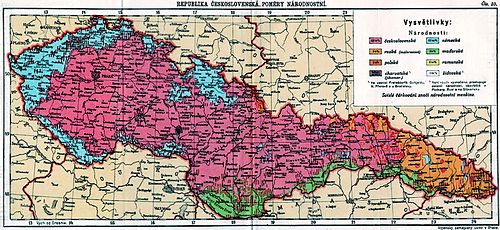File talk:Czechoslovakia 1930 linguistic map - en.svg
The map appears to be incorrect. See the old Czechoslovak map based on the Czechoslovak census of 1930 below. It is different than this map and the areas inhabitated by the Czechs and Slovaks are substantially smaller in this map than according to the Czechoslovak census.--Kostěj (talk) 21:09, 19 October 2010 (UTC)--Kostěj (talk) 21:12, 19 October 2010 (UTC)

Rusyn (Ruska) and Ukrainian edit
The language area shown in yellow would be correctly labeled "Rusyn and Ukrainian".
Rusyn is the internationally recognised name of the language spoken by the Lemko, Boyko and Hutsul minorities in the Transcarpathia region of Ukraine, Slovakia, Poland and Romania. Modern states in the region often do not recognise the separate endonym of Rusyn. However, the Rusyn language is recognised internationally as a separate language code rue under ISO 639-3 (and it has its own Wikipedia: https://rue.wikipedia.org).
This is shown in the map linked above, i.e. the language area in orange is labelled Ruska (Rusyn).
Note also that the obsolete/archaic English language name Ruthenian is ambiguous, as it may mean Rusyn and/or Ukrainian.
Grant65 (talk) 00:36, 13 August 2018 (UTC)
- Dear Grant65! You are trying in vain to explain anything in this situation. You think that someone just mistakenly called the Rusyns Ukrainians on this map. But the reality is much worse. The fact is that the Carpathian Rusyns of the 1930s were not just an ethnic group separate from Ukrainians, but also, in essence, a people who spoke a language close to the modern Russian language. To do this, it is enough to take any book in the Rusyn language published during this period of time. That is why, in a referendum in 1937, the Subcarpathian Rusyns chose Russian, and not Ukrainian, as the language of instruction in schools. But that's not all. If we start to understand further, then a logical question will arise: if the inhabitants of the Hungarian Subcarpathia were not Ukrainians, then were the inhabitants of Austrian Galicia, which was part of Poland in the 1930s, Ukrainians? And when you ask this question and start studying it, then suddenly the true cause of the current Russian-Ukrainian conflict will open up to you, which is not in the plane of the conflict between Russia and the West or Ukraine and pro-russian people (ethnic ukrainians) of Novorossiya, etc., but was born from a 100-year forced introduction of the people of Ukraine to the identity of Galicia, which is completely alien to them. Therefore, any hint of the truth is the worst thing for Ukrainian propaganda, which uses the current war as an excuse to complete the process of Galicization of Ukraine. That is why it is beneficial for them to present it as an ordinary imperialist war, where Ukraine is a battlefield. It is absolutely useless to try to convey the truth under these conditions. There is no such platform on the Internet that could objectively approach this issue. In connection with the above, you will not be able to change any of the Wikipedia maps by trying to rename Ukrainians to Rusyns. Don't even try to do it. There are people here who make sure that both texts and images correspond to the "correct" ideology...
Czech Corner missing edit
Dear Author of this map. Your have probably missed by error the Czech inhabitants of the so-called Czech Corner. Please indly correct this. Thank you NoychoH (talk) 14:42, 17 September 2023 (UTC)